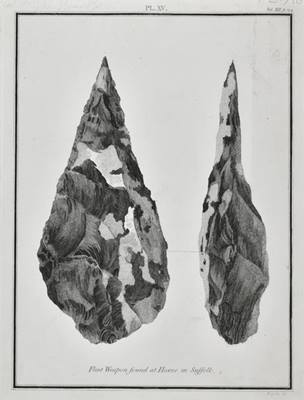John Evans and the Hoxne hand axes
 |
| Portrait of John Evans, 1877. Lithograph by William A Wragge. Archive ref: GSL/POR/53/28. |
Following the events of 1859, Evans would become one of the foremost experts on the stone and bronze implements used by prehistoric man.
Hoxne hand axes
The final proof for the Antiquity of Man came about rather by chance. More flints were found in the same pit at Saint-Acheul, and after a quick tour around the other gravel pits along the Somme Valley, Prestwich and Evans returned to Britain in May 1859 to write up their respective scientific papers on their findings. It was during this period that John Evans happened to be waiting for some friends in the rooms of the Society of Antiquaries at Burlington House when he spotted something which shocked him. In a display case were two flint tools which he described as-
“...so identical in character with some of those from the valley of the Somme, that they might be supposed to have been made by the same hand.” From John Evans, ‘Flint implements in the Drift, being an account of their discovery on the Continent and in England’, 1860.
 |
 |
| Left: Flint implements from the Brixham Cave’, from John Evans, ‘The Ancient Stone Implements, Weapons and Ornaments of Great Britain’, 1872. Right: One of the flint hand axes found at Hoxne, reprinted in John Evans, "Flint implements in the Drift; being an account of their discovery on the Continent and in England", 'Archaeologia', vol XXXVIII (1861). Archive ref: LDGSL/690. |
|
The flint tools which Evans saw had been found in a brick pit in Hoxne, Suffolk, by the antiquarian John Frere (1740-1807) nearly 60 years before. Frere had sent them to the Society of Antiquaries in 1797 along with a letter describing them as “weapons of war, fabricated and used by a people who had not the use of metals…”. Frere stated that great numbers of these worked flints were found at a depth of 12 feet in a “stratified” gravelly soil underlying a layer of sand, containing shells and “some extraordinary bones, particularly a jaw-bone of enormous size of some unknown animal, with the teeth remaining in it” .
Evans communicated with Prestwich at once to let him know of his discovery, and Prestwich lost no time hurrying to the site to inspect it for himself. There he met an old man who had worked the pit since 1801 who recalled these ‘fighting stones’ being found quite frequently. Although the pit had changed considerably since Frere’s time, both Prestwich and Evans found some examples in local antiquarians’ collections and a few in the pit itself along with the now expected extinct mammalian remains.
 |
| Portrait of Charles Lyell, by Albert Newsam & P S Duval from a daguerrotype by J E Mayall, 1850s. Archive ref: GSL/POR/53/12. |
In his opening address as President of the Geological Section at the Annual Meeting of the British Association for the Advancement of Science, in September 1859, Lyell announced that-
“...I am fully prepared to corroborate the conclusions which have been recently laid before the Royal Society by Mr. Prestwich, in regard to the age of the flint implements associated in undisturbed gravel, in the north of France, with the bones of elephants, at Abbeville and Amiens….I believe the antiquity of the Abbeville and Amiens flint instruments to be great indeed if compared to the times of history or tradition.”
This volume is the annual report of the 1859 meeting of the British Association. Immediately following Lyell’s description of the flints in the Valley of the Somme is the announcement of a forthcoming work which would set in motion the next scientific controversy concerning the history of humankind—Charles Darwin’s ‘On the Origin of Species’ which was published in November that year.
